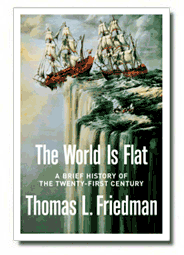https://en.wikipedia.org/wiki/The_World_Is_Flat

My computer science background, Professor Emerita SDSU of Computer Science, means I experienced the developments up do #3 below, which is characterized by the use of XML and SOAP.
https://flatworldbusiness.wordpress.com/flat-education/previously/flatteners-of-the-world/
https://en.wikipedia.org/wiki/The_World_Is_Flat

Here's what Wikipedia says about the flatteners:
Friedman defines ten "flatteners" that he sees as leveling the global playing field:
#1: Collapse of Berlin Wall--11/'89: The event not only symbolized the end of the Cold war, it allowed people from other side of the wall to join the economic mainstream. (11/09/1989)
#2: Netscape: Netscape and the Web broadened the audience for the Internet from its roots as a communications medium used primarily by 'early adopters and geeks' to something that made the Internet accessible to everyone from five-year-olds to ninety-five-year olds. (8/9/1995). The digitization that took place meant that everyday occurrences such as words, files, films, music and pictures could be accessed and manipulated on a computer screen by all people across the world.
#3: Workflow software: The ability of machines to talk to other machines with no humans involved. Friedman believes these first three forces have become a “crude foundation of a whole new global platform for collaboration.”
#4: Open sourcing: Communities uploading and collaborating on online projects. Examples include open source software, blogs, and Wikipedia. Friedman considers the phenomenon "the most disruptive force of all."
#5: Outsourcing: Friedman argues that outsourcing has allowed companies to split service and manufacturing activities into components which can be subcontracted and performed in the most efficient, cost-effective way.
#6: Offshoring: The internal relocation of a company's manufacturing or other processes to a foreign land in order to take advantage of less costly operations there.
#7: Supply chaining: Friedman compares the modern retail supply chain to a river, and points to Wal-Mart as the best example of a company using technology to streamline item sales, distribution, and shipping.
#8: Insourcing: Friedman uses UPS as a prime example for insourcing, in which the company's employees perform services--beyond shipping--for another company. For example, UPS repairs Toshiba computers on behalf of Toshiba. The work is done at the UPS hub, by UPS employees.
#9: In-forming: Google and other search engines are the prime example. "Never before in the history of the planet have so many people-on their own-had the ability to find so much information about so many things and about so many other people", writes Friedman. The growth of search engines is tremendous; for example take Google, in which Friedman states that it is "now processing roughly one billion searches per day, up from 150 million just three years ago".
#10: "The Steroids": Personal digital devices like mobile phones, iPods, personal digital assistants, instant messaging, and voice over Internet Protocol (VoIP).
In addition to the ten flatteners, Friedman offers "the triple convergence," three additional components that acted on the flatteners to create a new, flatter global playing field.
1. Up until the year 2000, the ten flatteners were semi-independent from one another. However, around the year 2000, all the flatteners converged with one another. This convergence could be compared to complementary goods, in that each flattener enhanced the other flatteners; the more one flattener developed, the more leveled the global playing field became.
2. After the emergence of the ten flatteners, a new business model was required to succeed. Instead of collaborating vertically (the top-down method of collaboration, where innovation comes from the top), businesses needed to begin collaborating horizontally. Horizontalization means companies and people collaborate with other departments or companies to add value creation or innovation. Friedman's Convergence II occurs when horizontalization and the ten flatteners begin to reinforce each other.
3. After the fall of the Berlin Wall, countries that had followed the Soviet economic model—including India, China, Russia, and the nations of Eastern Europe, Latin America, and Central Asia—began to open up their economies to the world. When these new players converged with the rest of the globalized marketplace, they added new brain power to the whole playing field and enhanced horizontal collaboration across the globe. In turn, Convergence III is the most important force shaping politics and economics in the early 21st century.